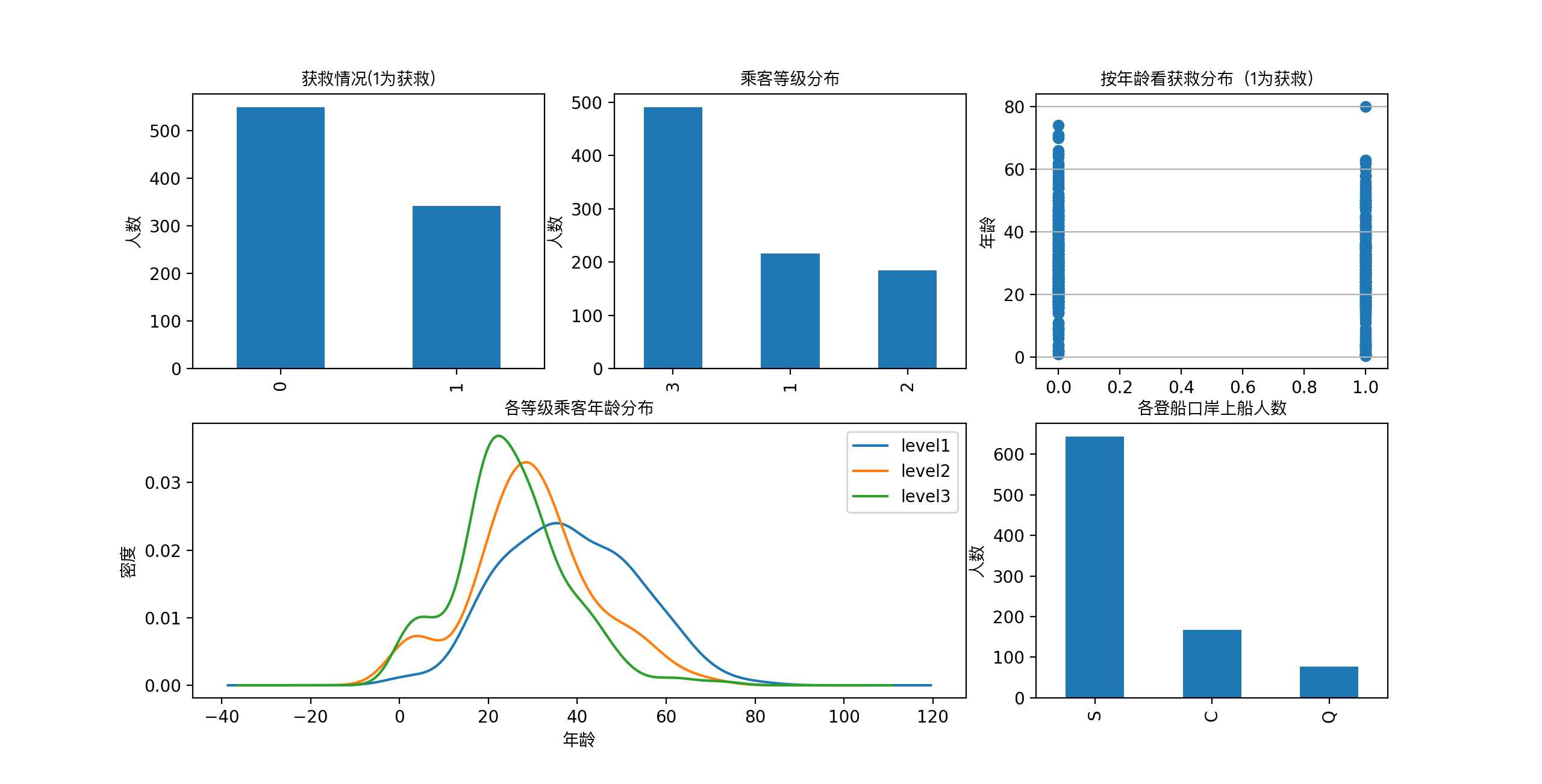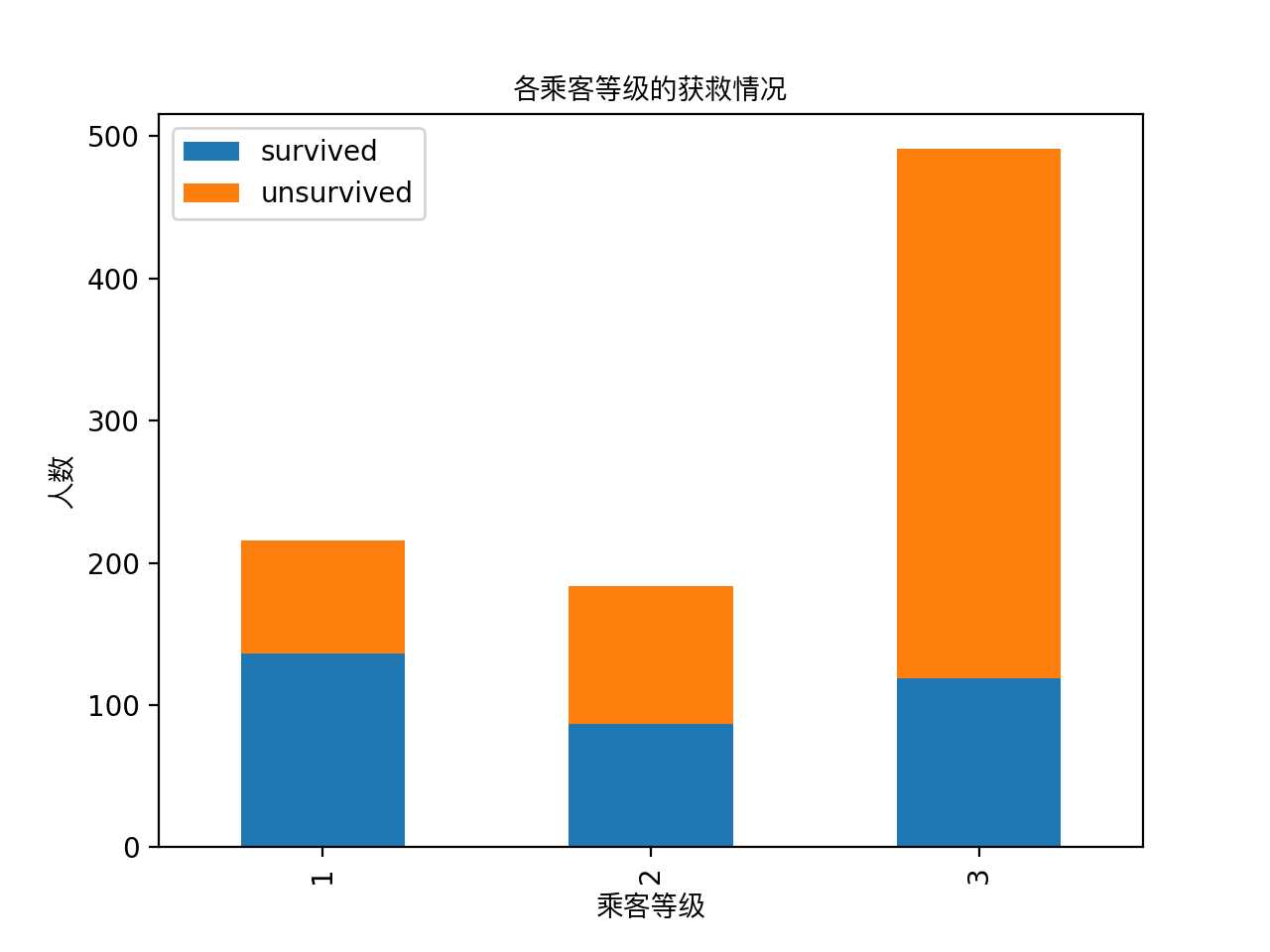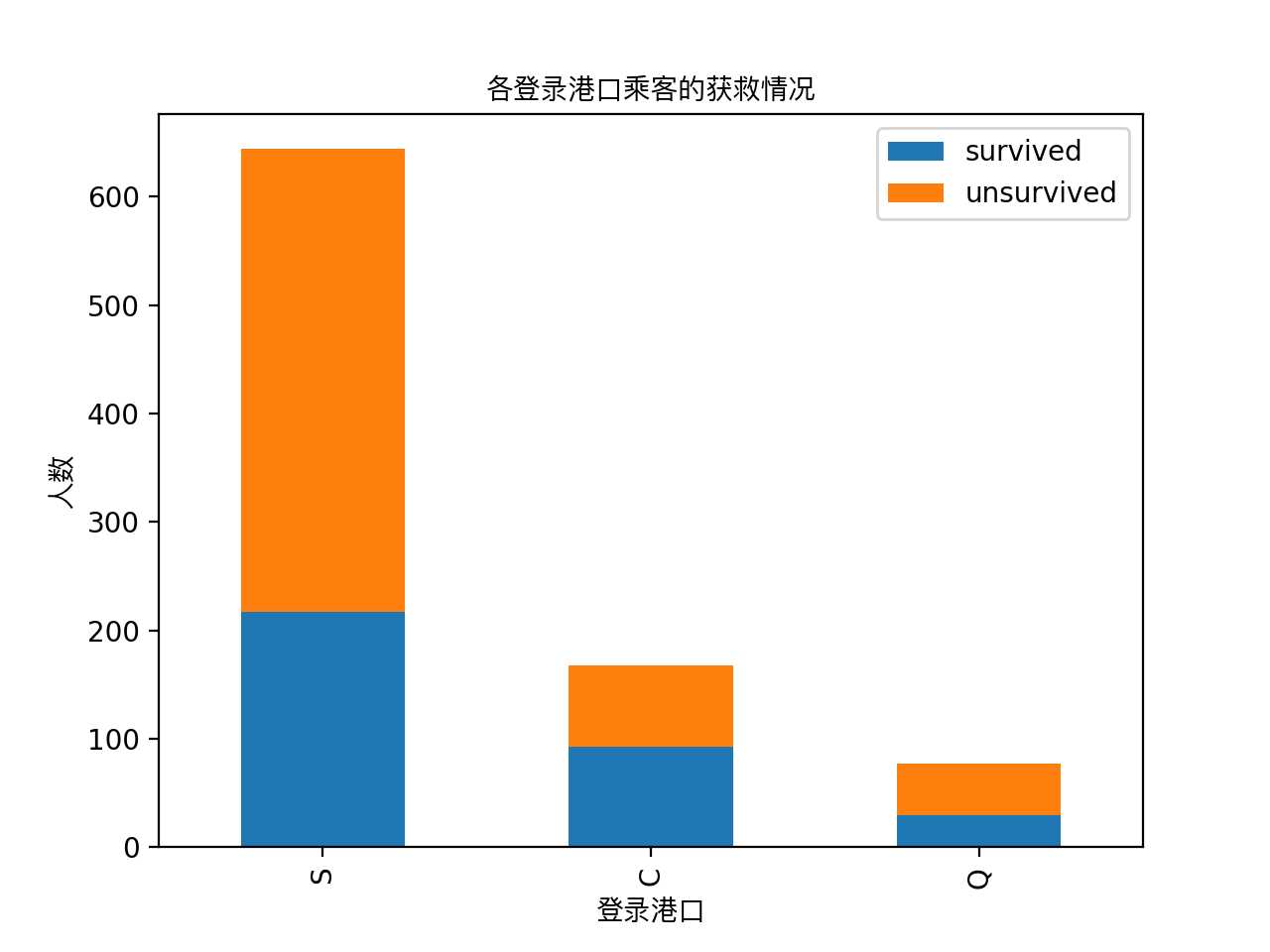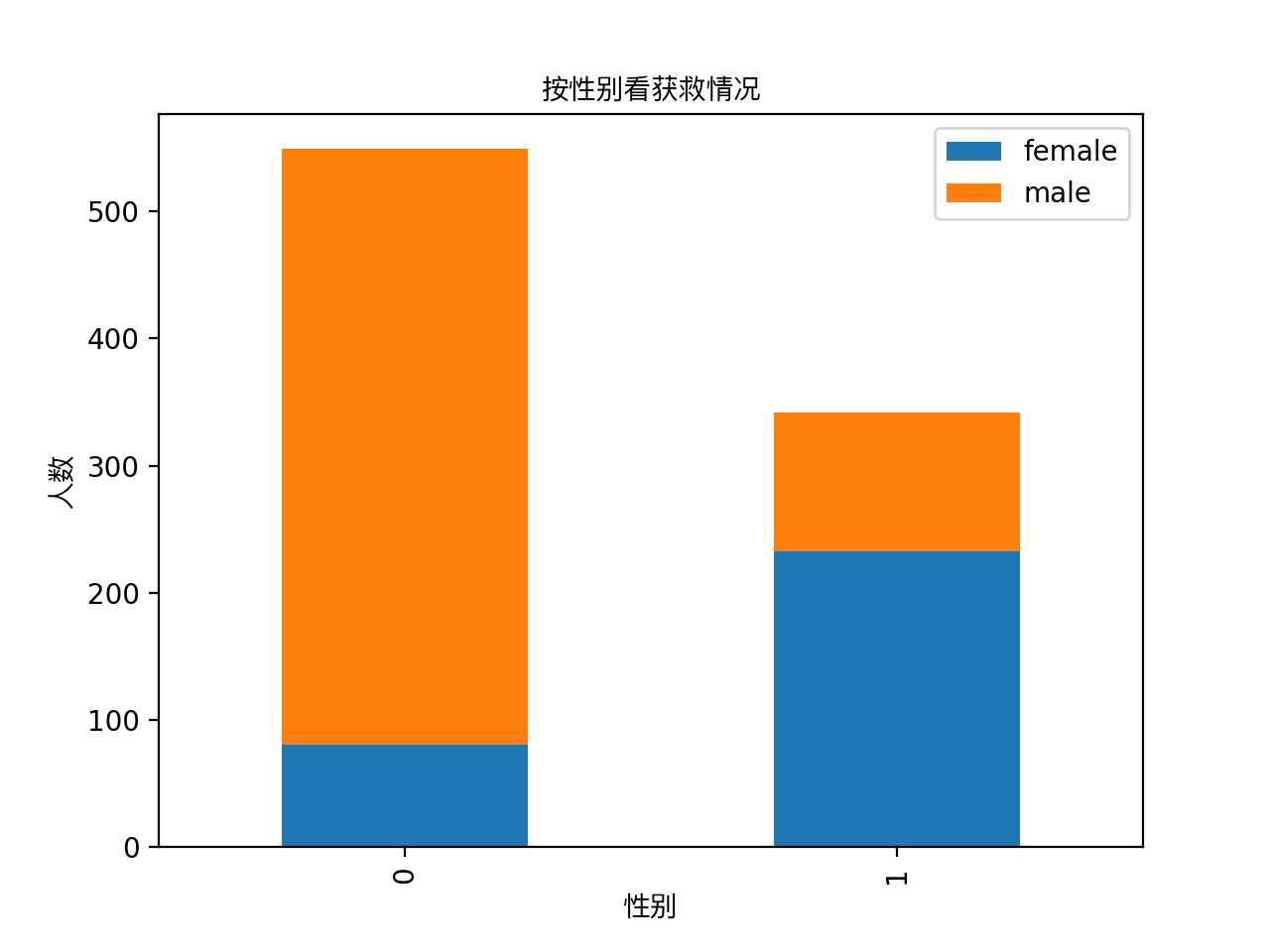标签:nbsp 二分 font span idt 分类 getc nump 一个
大家都熟悉的『Jack and Rose』的故事,豪华游艇倒了,大家都惊恐逃生,可是救生艇的数量有限,无法人人都有,副船长发话了『lady and kid first!』,所以是否获救其实并非随机,而是基于一些背景有rank先后的。
训练和测试数据是一些乘客的个人信息以及存活状况,要尝试根据它生成合适的模型并预测其他人的存活状况。
对,这是一个二分类问题,很多分类算法都可以解决。
看看数据长啥样
1 import pandas as pd 2 import numpy as np 3 from pandas import Series,DataFrame 4 5 data_train = pd.read_csv("Train.csv") 6 print(data_train.columns)
结果
Index([u‘PassengerId‘, u‘Survived‘, u‘Pclass‘, u‘Name‘, u‘Sex‘, u‘Age‘,u‘SibSp‘, u‘Parch‘, u‘Ticket‘, u‘Fare‘, u‘Cabin‘, u‘Embarked‘], dtype=‘object‘)
我们看大概有以下这些字段
PassengerId => 乘客ID
Pclass => 乘客等级(1/2/3等舱位)
Name => 乘客姓名
Sex => 性别
Age => 年龄
SibSp => 堂兄弟/妹个数
Parch => 父母与小孩个数
Ticket => 船票信息
Fare => 票价
Cabin => 客舱
Embarked => 登船港口
看一下数据的详细信息
print(data_train.info())
<class ‘pandas.core.frame.DataFrame‘>
RangeIndex: 891 entries, 0 to 890
Data columns (total 12 columns):
PassengerId 891 non-null int64
Survived 891 non-null int64
Pclass 891 non-null int64
Name 891 non-null object
Sex 891 non-null object
Age 714 non-null float64
SibSp 891 non-null int64
Parch 891 non-null int64
Ticket 891 non-null object
Fare 891 non-null float64
Cabin 204 non-null object
Embarked 889 non-null object
dtypes: float64(2), int64(5), object(5)
memory usage: 83.6+ KB
上面的数据说啥了?它告诉我们,训练数据中总共有891名乘客,但是很不幸,我们有些属性的数据不全,比如说:
似乎信息略少啊,想再瞄一眼具体数据数值情况呢?恩,我们用下列的方法,得到数值型数据的一些分布(因为有些属性,比如姓名,是文本型;而另外一些属性,比如登船港口,是类目型。这些我们用下面的函数是看不到的)
下面再看看每个/多个 属性和最后的Survived之间有着什么样的关系
1 # -*- coding:utf-8 -*- 2 import pandas as pd 3 import numpy as np 4 from pandas import Series,DataFrame 5 import matplotlib.pyplot as plt 6 from matplotlib.font_manager import FontManager, FontProperties 7 def getChineseFont(): 8 return FontProperties(fname=‘/System/Library/Fonts/PingFang.ttc‘) 9 10 11 data_train = pd.read_csv("train.csv") 12 #print(data_train.info()) 13 #print(data_train.describe()) 14 15 fig = plt.figure() 16 fig.set(alpha=0.2)#设定图表颜色alpha参数 17 18 plt.subplot2grid((2,3),(0,0)) #在一张大图里分列几个小图 19 data_train.Survived.value_counts().plot(kind=‘bar‘) #存活和不存活的条形图 20 plt.title(u"获救情况(1为获救)",fontproperties=getChineseFont()) 21 plt.ylabel(u"人数",fontproperties=getChineseFont()) 22 23 plt.subplot2grid((2,3),(0,1)) 24 data_train.Pclass.value_counts().plot(kind=‘bar‘) 25 plt.title(u"乘客等级分布",fontproperties=getChineseFont()) 26 plt.ylabel(u"人数",fontproperties=getChineseFont()) 27 28 plt.subplot2grid((2,3),(0,2)) 29 plt.scatter(data_train.Survived,data_train.Age) 30 plt.title(u"按年龄看获救分布(1为获救)",fontproperties=getChineseFont()) 31 plt.ylabel(u"年龄",fontproperties=getChineseFont()) 32 plt.grid(b=True,which=‘major‘,axis=‘y‘) #格式化图表的网格线样式 33 34 plt.subplot2grid((2,3),(1,0),colspan=2) 35 data_train.Age[data_train.Pclass == 1].plot(kind=‘kde‘) 36 data_train.Age[data_train.Pclass == 2].plot(kind=‘kde‘) 37 data_train.Age[data_train.Pclass == 3].plot(kind=‘kde‘) 38 plt.title(u"各等级乘客年龄分布",fontproperties=getChineseFont()) 39 plt.xlabel(u"年龄",fontproperties=getChineseFont()) 40 plt.ylabel(u"密度",fontproperties=getChineseFont()) 41 plt.legend(("level1","level2","level3"),loc=‘best‘) 42 43 plt.subplot2grid((2,3),(1,2)) 44 data_train.Embarked.value_counts().plot(kind=‘bar‘) 45 plt.title(u"各登船口岸上船人数",fontproperties=getChineseFont()) 46 plt.ylabel(u"人数",fontproperties=getChineseFont()) 47 48 plt.show()
得到了像下面这样一张图:

在图上可以看出来:
这个时候我们可能会有一些想法了:
下面我们再来统计统计,看看这些属性值的统计分布吧。
1 #看看各乘客等级的获救情况 2 fig = plt.figure() 3 fig.set(alpha=0.2) 4 5 Survived_0 = data_train.Pclass[data_train.Survived == 0].value_counts() 6 Survived_1 = data_train.Pclass[data_train.Survived == 1].value_counts() 7 df = pd.DataFrame({‘survived‘:Survived_1,‘unsurvived‘:Survived_0}) 8 df.plot(kind=‘bar‘,stacked=True) 9 plt.title(u"各乘客等级的获救情况",fontproperties=getChineseFont()) 10 plt.xlabel(u"乘客等级",fontproperties=getChineseFont()) 11 plt.ylabel(u"人数",fontproperties=getChineseFont()) 12 13 plt.show()

显然等级为1 的乘客获救概率更高,这一定是影响最后获救的一个特征。
1 #看看各登录港口的获救情况 2 fig = plt.figure() 3 fig.set(alpha=0.2) # 设定图表颜色alpha参数 4 5 Survived_0 = data_train.Embarked[data_train.Survived == 0].value_counts() 6 Survived_1 = data_train.Embarked[data_train.Survived == 1].value_counts() 7 df=pd.DataFrame({‘survived‘:Survived_1, ‘unsurvived‘:Survived_0}) 8 df.plot(kind=‘bar‘, stacked=True) 9 plt.title(u"各登录港口乘客的获救情况",fontproperties=getChineseFont()) 10 plt.xlabel(u"登录港口",fontproperties=getChineseFont()) 11 plt.ylabel(u"人数",fontproperties=getChineseFont()) 12 13 plt.show()

1 #看看各性别的获救情况 2 fig = plt.figure() 3 fig.set(alpha=0.2) # 设定图表颜色alpha参数 4 5 Survived_m = data_train.Survived[data_train.Sex == ‘male‘].value_counts() 6 Survived_f = data_train.Survived[data_train.Sex == ‘female‘].value_counts() 7 df=pd.DataFrame({‘male‘:Survived_m, ‘female‘:Survived_f}) 8 df.plot(kind=‘bar‘, stacked=True) 9 plt.title(u"按性别看获救情况",fontproperties=getChineseFont()) 10 plt.xlabel(u"性别",fontproperties=getChineseFont()) 11 plt.ylabel(u"人数",fontproperties=getChineseFont()) 12 plt.show()

歪果盆友果然很尊重lady,lady first践行得不错。性别无疑也要作为重要特征加入最后的模型之中
标签:nbsp 二分 font span idt 分类 getc nump 一个
原文地址:http://www.cnblogs.com/freeman818/p/7813735.html